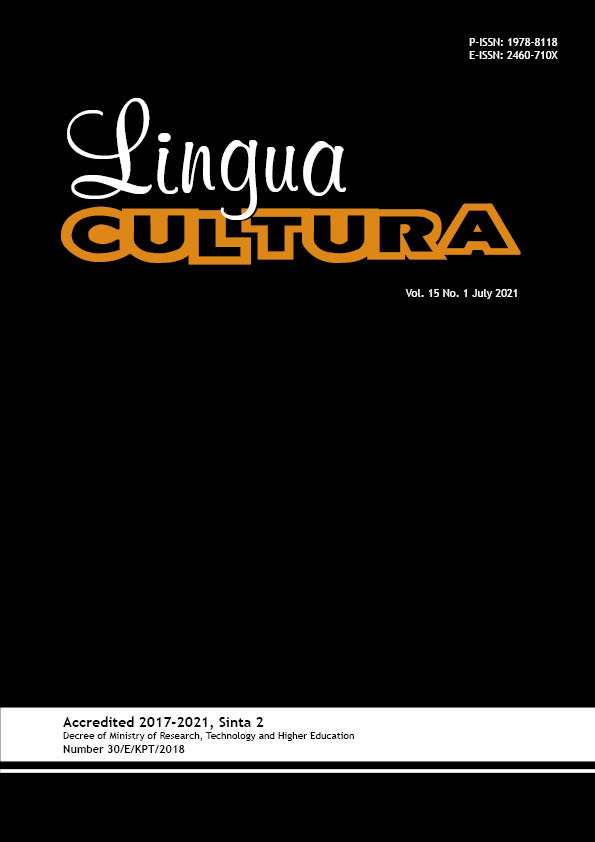The Reflexive Pronoun of the Bidayuh-Somu Language: Its Comparable Process to English Language Suffix -self/-selves
DOI:
https://doi.org/10.21512/lc.v15i1.6897Keywords:
reflexive pronoun, derivational prefix, inflectional suffixAbstract
The research aimed to describe the reflexive pronoun of the language of the Bidayuh-Somu and English in terms of its formation process. The research data were reflexive pronoun of the Bidayuh-Somu language taken from the dissertation and the English language reflexive pronoun taken from the website. The method of research was comparative, and the technique of data analysis was descriptive. It is found that morphologically, the reflexive pronoun of the Bidayuh-Somu language is formed by attaching the prefix goni- that is derivational to free morpheme. In the English language, the reflexive pronoun is formed by affixing the suffix -self/-selves that is inflectional to free morpheme. The free morpheme, in the case of these two languages, is a personal pronoun. In terms of function, the two morphemes are both class-maintaining. Furthermore, in terms of word meaning, they are unchanged. The complex word the prefix goni- forms is prefixal, while the complex word the suffix -self/-selves forms are suffixal. The importance of comparing the prefix goni- with the suffix -self/-selves is to linguistically provide a description of similarities in terms of the morphological process for reflexive pronoun formation. Although the process of affixation is different, one employs derivational, and the other one applies inflectional. However, the description indicates that the two affixes are similar in terms of duty to reflexive pronoun formation. In the syntactic model of morphology, the use of the two reflexive pronouns is to intensify or emphasize the personal pronoun. They reflect upon the sentences’ subjects or as antecedents of the subjects in sentences.
References
Antón-Méndez, I. (2020). The role of verbs in sentence production. Frontiers in Psychology, 11, 1-12. https://doi.org/10.3389/fpsyg.2020.00189.
Arista, J. M. (2019). Another look at old English zero derivation and alternations. Atlantis English Studies, 41(1), 1-14. https://doi.org/10.28914/Atlantis-2019-41.1.09.
Bauer, L., & Lieber, R. (2014). The Oxford reference guide to English morphology. Oxford: Oxford University Press. Retrieved from https://doi.org/10.5860/choice.51-4169.
Bernstein, S. E., Flipse, J. L., Jin, Y., & Odegard, T. N. (2020). Word and sentence level tests of morphological awareness in reading. Reading and Writing, 33(6), 1591-1616. https://doi.org/10.1007/s11145-020-10024-6.
Booij, G. (2019). The role of schemas in construction morphology. Word Structure, 12(2), 385-395. https://doi.org/10.3366/word.2019.0154.
Bossuyt, T. (2020). Song, Jae Jung 2018 linguistic typology. Studies in Language, 44(3), 722-728. https://doi.org/10.1075/sl.20014.bos.
Bunau, E. (2019). Morfologi bahasa Bidayuh-Somu kabupaten Sanggau, Kalimantan Barat. Kuala Lumpur: Universitas Malaya.
Bunau, E., & Yusof, R. M. (2018). Morpheme {buN-}: An example of morphological process through affixation in Bidayuh-Somu language. Lingua Cultura, 12(2), 203-208. https://doi.org/10.21512/lc.v12i2.3962.
Ershova, K. (2020). Two paths to polysynthesis: Evidence from West Circassian nominalizations. Natural Language and Linguistic Theory, 38(2), 425-475. https://doi.org/10.1007/s11049-019-09455-w.
Glen, S. (2018). Primary data & secondary data: Definition & example. Retrieved from https://www.statisticshowto.com/experimental-design/primary-data-secondary/.
Haspelmath, M. (2020). The structural uniqueness of languages and the value of comparison for language description. Asian Languages and Linguistics, 1(2), 346-366. https://doi.org/10.1075/alal.20032.has.
Hassan, R., Ghazali, K., & Omar, A. H. (2015). Vitality of the Orang Asli languages in Gerik, Perak. Oceanic Linguistics, 54(2), 492-506. https://doi.org/10.1353/ol.2015.0026.
Hayriyan, A. (2020). Deverbal nominals possess no internal VP structure. Lingua, 248, 102884. https://doi.org/10.1016/j.lingua.2020.102927.
Khamis, N., & Musa, N. F. (2020). Corpus-based data for determining specialised language features. International Journal of Advanced Trends in Computer Science and Engineering, 9(1), 36-41. https://doi.org/10.30534/ijatcse/2020/07912020.
Larson, R. K., & Samiian, V. (2020). Ezafe, PP and the nature of nominalization. Natural Language and Linguistic Theory, 39, 157-213. https://doi.org/10.1007/s11049-020-09471-1.
Manggala, I. P. A. (2018). Derivational noun in the economist magazine “The Trump presidency so farâ€. Jurnal Humanis, 22(2), 447-452. https://doi.org/10.24843/jh.2018.v22.i02.p24.
Momma, S., Buffinton, J., Slevc, L. R., & Phillips, C. (2020). Syntactic category constrains lexical competition in speaking. Cognition, 197, 104183. https://doi.org/10.1016/j.cognition.2020.104183.
Round, E. R., & Corbett, G. G. (2020). Comparability and measurement in typological science: The bright future for linguistics. Linguistic Typology, 24(3), 489-525. https://doi.org/10.1515/lingty-2020-2060.
Rugaiyah, R. (2018). Derivational and inflectional morphemes: A morphological analisis. J-SHMIC: Journal of English for Academic, 5(2), 73-85. https://doi.org/10.25299/jshmic.2018.vol5(2).1887.
Song, J. J. (2018). Linguistic typology. Oxford: Oxford University Press.
Stern, N. (2019). Ourself and themself: Grammar as expressive choice. Lingua, 226, 35-52. https://doi.org/10.1016/j.lingua.2019.05.005.
Traffis, C. (2020). What is a reflexive pronouns? Retrieved from https://www.grammarly.com/blog/reflexive-pronouns.
van Gelderen, E. (2019). Reflexive pronouns in the Lindisfarne glosses. NOWELE: North-Western European Language Evolution, 72(2), 220-244. https://doi.org/10.1075/nowele.00028.gel
Downloads
Published
How to Cite
Issue
Section
License
Copyright (c) 2021 Eusabinus Bunau

This work is licensed under a Creative Commons Attribution-ShareAlike 4.0 International License.
Authors who publish with this journal agree to the following terms:
a. Authors retain copyright and grant the journal right of first publication with the work simultaneously licensed under a Creative Commons Attribution License - Share Alike that allows others to share the work with an acknowledgment of the work's authorship and initial publication in this journal.
b. Authors are able to enter into separate, additional contractual arrangements for the non-exclusive distribution of the journal's published version of the work (e.g., post it to an institutional repository or publish it in a book), with an acknowledgment of its initial publication in this journal.
c. Authors are permitted and encouraged to post their work online (e.g., in institutional repositories or on their website) prior to and during the submission process, as it can lead to productive exchanges, as well as earlier and greater citation of published work.
USER RIGHTS
All articles published Open Access will be immediately and permanently free for everyone to read and download. We are continuously working with our author communities to select the best choice of license options, currently being defined for this journal as follows: Creative Commons Attribution-Share Alike (CC BY-SA)


















